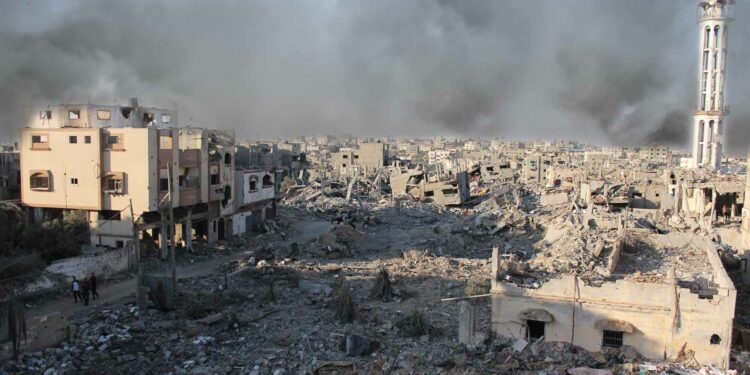Israel’s still unfolding war on Gaza is in its eighth month with end in sight. The Palestinian death toll has surpassed 36,000 with more than 80,000 injured. More than 80 percent of Gaza’s population, 1.9 million, have been displaced. At least 62 percent of homes, almost 300,000, have been rendered uninhabitable, and damage to infrastructure stands at some $18.5 billion. Famine has set in in many areas of the Gaza Strip because of Israel’s policy of denying the entry of food. The impending full-invasion of the southern city of Rafah where some 1.4 million Palestinians now live will significantly deepen the humanitarian tragedy.
It is difficult to predict how any war ends but some patterns are already discernible. First, Israeli-Palestinian peace is now less likely than at any time in recent memory. Second, the situation on the Lebanese-Israeli border has become fraught with daily skirmishes, making all-out war between Israel and Hezbollah a real possibility. Third, the strategic equation in the region has shifted dramatically with irregular armies becoming increasingly prominent in the fight against Israel – and there is the potential of Iran’s direct involvement in any all-out war with Israel.
Palestinian-Israeli Peace Is Less Likely Than Ever
There have been wars, clashes, attacks, and counter-attacks since the Israeli occupation of Gaza in 1967. Specifically, the 2008-9, 2014, and 2019 strikes on Gaza led to high civilian casualties and heavy destruction of property. However, the current war on Gaza is different. Not only are the casualties and destruction on a much larger scale, but also the intent of the Israeli decision-makers and right-wing settlers in the occupied West Bank seems much more ambitious. As early as January 2024, OXFAM reported that the civilian casualties among Palestinians had already exceeded those of any other conflict in the 21st century. Since then, the situation has only gotten worse. In the early days of the war there were roughly 300 Palestinian casualties per day, 70 percent of whom were women and children. United Nations Secretary General António Guterres expressed his alarm in January at the toll the war was taking on civilians in Gaza and termed it “unacceptable.” The psychological toll this has taken on Palestinians is hard to assess. Beyond the trauma, which is likely to last for years, the anger over the destruction and loss of loved ones will likely rage for years to come.
Israel’s right-wing ministers and Knesset members have made clear from the start of offensive operations in Gaza that they aspire to far more than a military defeat of Hamas. Coupled with a steady harassment and dispossession of Palestinians in the West Bank, the far right aspires to clear the area ‘from the river to the sea’ of as many Palestinians as possible to allow for an all-out expansion of settlements in both the West Bank and Gaza
In the current atmosphere of a genocidal Israeli war against Gaza, two generally contemplated resolutions of the Palestinian-Israeli conflict are equally difficult to imagine: the two-state solution and the one state solution.
The Two-State Solution
Touted by the Biden administration as the official American policy, the two-state solution stands very little chance of success in the face of geopolitical and emotional realities on the ground. The existing occupation encircling most Palestinian towns and the expansion of settlements already in place in the occupied West Bank leave little physical space for a potential Palestinian state. The Oslo Accords of the 1990s and the Palestinian-Israeli negotiations sponsored by former President Bill Clinton came close to achieving an agreement on a Palestinian state covering some 97 percent of the West Bank, the Gaza Strip, and East Jerusalem. In the end, the status of Jerusalem and the right of Palestinian refugees to return to their homes were obstacles that could not be overcome. The assassination of Israeli Prime Minister Itzhak Rabin in 1995 arguably sealed the fate of the two-state idea for right-wing Israelis (who now are an electoral majority), and unleashed a wave of expansion in settlements in the West Bank, which contributed to the eruption of a second Palestinian Intifada in 2000.
In addition to frustration with the peace process and the rising anger because of the devastation in Gaza, there is increasingly precious little land the Israelis could set aside for a Palestinian state without displacing its own settlers, assuming a future Israeli government could even agree to that solution. There are some 700,000 Jewish settlers in the West Bank and their number is likely to increase, further impacting Palestinian land, towns, and resources. Assuming some kind of home-rule for Palestinians in a future Palestinian state—not too different from what exists now—their land would be totally surrounded by settlements and security outposts. In fact, the large Ma’ale Adumim settlement, east of Jerusalem and jutting out toward the Jordan River, has plans to become connected to security outposts along the waterway, rendering a Palestinian West Bank not only land-locked but also divided in half. In other words, what is likely to be approved for Palestinians is cantonized along the lines of South Africa’s Bantustans where Blacks were forced to live under the apartheid system—a reality that did not change until it was dismantled under international pressure in 1990.
The One-State Solution
Some Palestinian factions and analysts have long advocated a one-state model where Arab and Jew can live side-by-side as equal citizens in a democratic state. The late Edward Said, a scholar, historian, and literary critic who was at one point a member of the Palestine National Council, was among those who advocated this solution in 1999 as a challenging weaving together of two opposed national movements, Palestinian and Jewish. But given the existing mutual hatred, fear, and paranoia today, it is hard to imagine how Palestinians and Israelis could one day coexist, let alone live as one nation in one democratic state.
For this solution to assure Palestinian-Israeli peace, the first step would have to be ending the occupation and gradually developing peaceful coexistence under new visionary leadership on both sides. New Palestinian leaders who have proven their credentials among Palestinians and offer democratic alternatives can provide necessary leadership. There are many visionaries on Israel’s left who would qualify, but currently none are anywhere near the seats of power.
Israel-Hezbollah War
Fighting along the Lebanese-Israeli border has intensified gradually since the start of Israel’s war on Gaza. Since October 8, Israel has launched the majority of attacks (close to 5,000) and caused the highest number of casualties (almost 350 dead). Even though Hezbollah is likely the most powerful and battle-hardened non-state actor in the region, equipped with an estimated 100,000 fighters and between 130,000 and 150,000 missiles, Israel has the larger and more long-range arsenal, in addition to the most powerful and sophisticated air force in the region. An all-out war between the two would definitely hurt Israel but would be devastating for Lebanon and likely reverberate throughout the region for a long time to come.
Both Hezbollah and Israel have so far appeared reluctant to go to a full war. The United States has been trying to dissuade both sides, sending Special Envoy Amos Hochstein to mediate and try to help the protagonists reach an understanding if not a full accommodation. France has also been working closely with the United States to help prevent a war in the short-run and perhaps dampen internal conflict in Lebanon in the long term. Given constant Israeli threats and incursions and Hezbollah’s solidarity with the Palestinians and deep distrust of Israeli plans for Gaza and Lebanon, French-American mediation efforts face a steep uphill struggle.
The Changing Strategic Equation in the Region
When Iran took the unprecedented step on April 13 of launching 300 missiles and drones at Israel, it changed a practice of several decades of not responding directly to Israeli attacks on its military personnel, nuclear scientists, and assets in Syria. Israel crossed a line by attacking Iran’s diplomatic mission in Damascus on April 1. Although of questionable military value, Iran’s retaliatory strike directly on Israeli territory changes the strategic equation in the region by throwing the Islamic Republic’s weight directly on the side of its non-state allies in the region, which presents the risk of a wider and more deadly armed conflict. Some analysts believe that Iran’s strike was intended to be symbolic of its resolve and ability to launch a war directly from its own territory.
In addition to Iran’s potential direct involvement in an all-out war, the Axis of resistance groups supported by Iran form a qualitatively different fighting force than the Arab armies that fought several wars with Israel in the past. Hezbollah, Hamas, Ansar Allah and the PMF in Iraq are popular forces that reflect the pro-Palestinian Arab popular opinion and an uncompromising opposition to Israeli occupation. The current war in Gaza and previous wars fought by Hezbollah against Israel reveal the difficulties of a regular army like the Israeli IDF fighting irregular armies immersed in guerrilla-fighting techniques but equipped with modern precision missiles.
The Abraham Accords, sponsored by the Trump administration and adopted by President Biden will have little dampening effect on these groups’ will to fight. The big picture for peace in the Middle East is dimmer than it has ever been.
Dr. Nabeel A. Khoury is currently a non-resident senior fellow at the Arab Center in Washington, DC and the author of Bunker Diplomacy: An Arab-American in the U.S. Foreign Service. He served in the US foreign service for 25 years, holding roles such as deputy chief of mission at the U.S. embassy in Yemen and spokesperson at US Central Command in Doha and in Baghdad during the Iraq war in 2003. He served as director of the office of Near East and South Asia at the Bureau of Intelligence and Research (INR).






